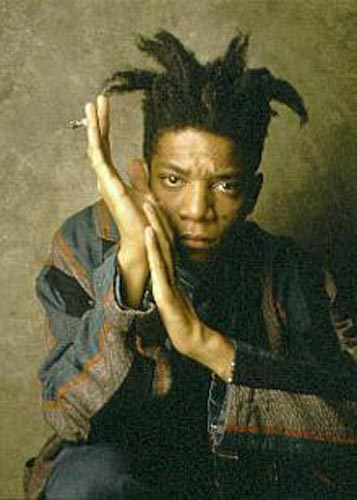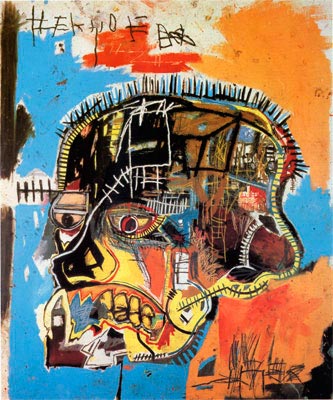| Jean-Michel Basquiat | |
|---|---|
 |
|
| Born | Dec. 22, 1960 Brooklyn, New York City, U.S. |
| Died | Aug. 12, 1988 (at age 27) Manhattan, New York City, U.S. |
| Nationality | American |
| Movement | Neo-expressionism, Primitivism |
| Field | Graffiti, painting, poetry, musician, producer |
| Works | View Complete Works |
Jean-Michel Basquiat was an American artist of the Neo-Expressionism and Primitivism art movements. Basquiat produced graffiti, paintings, poetry, and music. He was world-famous by the age of twenty-three, and has been credited for bringing the African-American and Latino cultural experience into the elite art world. Although his life ended tragically and early, he is considered an exceptionally creative talent, and he became a cultural hero, to many young artists. His artwork collections are on display in Europe, Canada, Asia, and the United States.
Influential Experiences
Jean-Michel was born in Brooklyn, New York of a father from Haiti, and a mother of Puerto Rican descent. He was able to read and write by the age of four, and was a very precocious child. His teachers recognized his artistic abilities, and he became a fluent speaker and writer of French, Spanish, and English, by the age of eleven.
At the age of eight, Jean-Michel was struck by a car, while playing in the street, leaving him with internal injuries, and a broken arm. His parents separated that year, and he was raised by his father. His mother was committed to a mental institution when he turned eleven, and when he was fifteen, Jean-Michel ran away from home, dropped out of school, and roomed with some friends in Brooklyn. He supported himself by creating post cards to sell on the streets, and selling T-shirts at a clothing warehouse.
Evolution as an Artist
In 1976, he and a friend began spray-painting graffiti on Lower Manhattan buildings, using the alias SAMO, standing for same old shit. In 1979, Basquiat formed a rock band called Test Pattern, later becoming Gray. The band played at Arleen Schloss’ Open Space, or A’s, and various other clubs in New York. While at a restaurant in 1980, he met Andy Warhol, and presented samples of his work for him to view. Warhol was intrigued and stunned by Basquiat’s art genius, and later collaborated with Basquiat.
 Soon after this meeting, Jean-Michel appeared on The Times Square Show, a multi-artist exhibition, and it brought Basquiat’s work to the attention of the art world. In 1983, Andy Warhol and Basquiat worked together on a series of collaborative paintings, one of which is the Olympic Rings. Basquiat also continued to do guest appearances on television, gallery showings, films, and music videos. By 1986, Basquiat was displaying artwork in Southern Manhattan, and his work was featured on the cover of The New York Times Magazine.
Soon after this meeting, Jean-Michel appeared on The Times Square Show, a multi-artist exhibition, and it brought Basquiat’s work to the attention of the art world. In 1983, Andy Warhol and Basquiat worked together on a series of collaborative paintings, one of which is the Olympic Rings. Basquiat also continued to do guest appearances on television, gallery showings, films, and music videos. By 1986, Basquiat was displaying artwork in Southern Manhattan, and his work was featured on the cover of The New York Times Magazine.
Basquiat had become a successful, young artist, but his addiction to heroin began to interfere with his work and scheduled appearances. In 1987, Andy Warhol passed away, and Basquiat started to withdraw from the public eye and isolate himself. Severely addicted and depressed, he experienced a failed attempt at sobriety during a trip to Hawaii. He returned to his art studio, Great Jones Street, New York City, and at age twenty-seven, died of an overdose.
Art Style And Medium
Basquiat incorporated written words and symbols into his paintings. His text elements were codes, acronyms, words, letters, numbers, pictograms, logos, and maps, to name a few. Some of the more significant trademark images used were the crown, which was a sign of respect for his heroes, and CPRKR, used to represent the jazz musician Charlie Parker, who helped to create bebop music, which he loved. One of Basquiat’s major reference sources, was the Gray’s Anatomy book which was given to him by his mother when he was in the hospital after being hit by a car.
Basquiat was fascinated with the process of creating. He liked to reveal what made people tick, and this was displayed in his artwork as well. At times, Basquiat would reveal the pieces of wood used to hold the canvas, displaying what was behind the work of art. He created on all types of materials, using random objects, and various surfaces as his canvas. He used acrylic paints which would drip down the canvas, spray paints, and oil paint sticks, which were like giant crayons, on canvas, paper, masonite, and walls.
 Basquiat was influenced by the artwork of Jean Dubuffet, and his idealistic approach to aesthetics, Pablo Picasso’s collage and cubism, Robert Rauschenberg’s Neo-Dada, abstract expressionism, and Cy Twombly’s calligraphic, large graffiti paintings. He was especially intrigued by Andy Warhol and the pop-art movement. He respected as well as collaborated with Warhol.
Basquiat was influenced by the artwork of Jean Dubuffet, and his idealistic approach to aesthetics, Pablo Picasso’s collage and cubism, Robert Rauschenberg’s Neo-Dada, abstract expressionism, and Cy Twombly’s calligraphic, large graffiti paintings. He was especially intrigued by Andy Warhol and the pop-art movement. He respected as well as collaborated with Warhol.
Jean-Michel Basquiat used social commentary in order to delve into deeper truths about people. He focused on dichotomies such as wealth and poverty, integration and segregation, and inner and outer life experiences. Utilizing poetry, drawing, and painting, he united text and image, using abstraction, figuration, historical, and contemporary art elements. He began as an obscure graffiti artist in New York City in the late 1970’s, gradually evolving into a world-acclaimed painter before his short life ended.